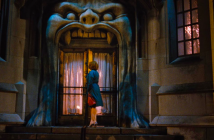Alive (2014)
Cast: Seung-yeon Lee, Myoung-Hoon Park, Haet-Bit Shin
Directors: Jung-bum Park
Country: South Korea
Genre: Drama
Editor’s Notes: The following review is part of our coverage of the AFI FILM FEST 2014. For more information on the festival visit afi.com/afifest and follow AFI on Twitter at @AmericanFilm.
Park Jung-bum’s second feature, one of the Jeonju Digital Project feature films for 2014, begins with a man chopping wood in the countryside, in the bitter cold. He is alone and determined in his actions, captured in long takes. The next sequence consists of a woman whose face we do not see; with her back to the camera, she takes off her blouse and begins to flagellate herself with a branch. She then nears the wall of the room in what appears to be an abandoned building and presses her hand and back against a protruding nail, also captured in a long take. These two hyper-corporeal sequences establish the film’s simple, stark perspective and subject of hand-to-mouth survival, familial bonds, and desires. As with his 2010 feature debut Journals of Musan—in which he plays the lead—Park here presents peripheral lives of struggle and will. Though its nearly three-hour running time veers towards the exhausting, given the film’s sustained bleakness, it presents an impressive, gritty documentary realism and affective ensemble performance.
Park structures the story of his characters in an episodic way, and constantly switches between Jeong-cheol’s perspective and that of Su-yeon. In this way, Park registers in acute detail the (gendered) nuances of hardship, emotional and physical, of this world for his characters.
The film follows the arduous life of Jeong-cheol (Park) and his mentally ill sister Su-yeon (Lee Seong-yeon), whose parents died several years ago. The brother and sister live itinerant lives, as they look for work according to the seasons. With the onslaught of winter, the urgency to find work becomes that much more intense. The beginning of the film finds Jeong-cheol and his coworkers bilked out of their pay because their boss has run off with the till. They compensate for their loss by going to their boss’ place, asking his son of his whereabouts, and promptly unhinging the house’s front door. And so the pursuit of work and some semblance of stability recommences.

Park structures the story of his characters in an episodic way, and constantly switches between Jeong-cheol’s perspective and that of Su-yeon. In this way, Park registers in acute detail the (gendered) nuances of hardship, emotional and physical, of this world for his characters. Jeong-cheol is concerned above all with earning steady money in order to build up his ramshackle house, and in the process provide a home base for his girlfriend and himself. Though taciturn, he is a hard worker and unhesitant when it comes to voicing his opinion or getting money that he has earned. In short, Jeong-cheol is a quiet man on a mission, performed with a steely precision by Park.
Unfortunately, his life is just as much about searching for Su-yeon during her fugues—which often involve having sex with strangers and self-mutilation/loathing—as it is about manual labour. Throughout the film, Su-yeon is exasperating, pitiful, and enigmatic, as the film never clearly articulates what torments her (though it implies well enough that her traumatic state relates to her parents’ death). As Su-yeon, Lee is fearless. She dives headlong into the character’s broken psyche and its outward manifestations, and presents a living, scarred being. Such a role is all the more difficult since Su-yeon does not have much dialogue.
Park thus paints, in a terse, blunt fashion, a skewed social order where money that could pay for the yearly salary of two workers goes to a television set.
Interestingly, the characters with the most dialogue are the secondary characters of Ha-na (Shin Haet-bit), Su-yeon’s little girl, and Myeong-hoon (Park Myeong-hoon), Jeong-cheol’s friend and coworker. These two characters help constitute the film’s makeshift family. Perhaps most significantly, they also present a necessary lighter, childlike (for Myeong-hoon is mentally slow) side within Jeong-cheol and Su-yeon’s otherwise austere world. More specifically, each of them embodies hopes and desires indicative of their age and/or their current life conditions: Ha-na wants to excel in piano while Myeong-hoon wants to emigrate to the Philippines. The feasibility of each desire is almost beside the point; what matters is that they do harbour such desires. Ha-na’s act of setting a bird free from a window instead of returning it to its cage is an expression of this point. Her decision to free the bird is all the more defiant in its own way since she does so partly in response to the owner, who mentions that she starves the bird to make it more obedient as part of a show. One can even go so far as to draw a parallel between the bird and the daily hustle that is Jeong-cheol and Myeong-hoon’s lives.
On this last note, the thematic and environmental core of the film is certainly the soybean fermentation farm. It is the site of not only Jeong-cheol and company’s workplace for a sustained period of time but also a microcosm of a tough, everyone-for-him/herself society presented in the plainest of terms: to keep their jobs, Jeong-cheol makes a deal with the boss with regards to the older (slower) workers; yet after a mistake that ruins a batch of soybean slabs, the boss lets everyone go for the sake of his daughter’s impending marriage; for the daughter and her family are burdened with a ridiculously expensive wedding gift requested by the rich groom’s mother. Park thus paints, in a terse, blunt fashion, a skewed social order where money that could pay for the yearly salary of two workers goes to a television set.
Though its nearly three-hour running time veers towards the exhausting, given the film's sustained bleakness, it presents an impressive, gritty documentary realism and affective ensemble performance.



